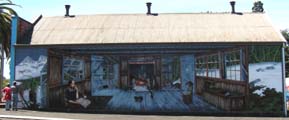The Sheffield Murals |
|
"STILLNESS AND WARMTH" This was the first Mural to be painted in Sheffield as part of
the Murals Project. The theme is taken from the words of Weindorfer's diary, as shown
in the Mural: Weindorfer was born in Austria and came to Melbourne in 1900 to work at the Austrian Consulate. He met his wife-to-be, Kate Cowle, while they were members of
the Victorian Field Naturalists' Club and when they married in
1906, they came to Tasmania spending their honeymoon on top of
Mt. Roland.
"CHRISTIAN
HERITAGE" In the early 1860's Mrs. Eliza von Bibra stands
on the verandah of her West Kentish home ready to teach the first
Sunday School, while her husband Francis guides the first clergyman
through the bush to the new settlement. The first church was
erected by the Methodist pioneers at Barrington. One of these Evangelists, Chas. Perrin from Ireland, aged 33 died and was buried at Forth. The Christian Brethren pioneers named such places as Paradise, Beulah and the Promised Land. In the mid 1880's, the Anglican Minister from Latrobe commenced
visiting the Kentish district, which resulted in building St. Barnabus
Church of England in Main Street. The Salvation Army held their first street meeting in the mid 1880's
and later erected a building on the road to the Promised land -
Following the visit of a Baptist Pastor in the late 1880's a Baptist
Tabernacle was erected in 1891 and other district churches were
built at about the same time. The tents depict the beginning of
Christian camping in Tasmania. In 1922 the foundation stone of the Holy Cross Roman Catholic church
in High Street was laid. The mural concludes with the Risen Christ pointing to the workers' mission fields, where about sixty Kentish descendants have taken their faith .... some like Bert Overton of India, giving their lives to bring the "Good News" to others. In 1988 this mural was located at 55 Main Street,
Sheffield, behind the "Cradle Mountain Beauty" mural,
on the property of what was then the Westpac Bank. In September 2002 the mural was relocated to the
current site (beside the visitor centre).
|
|
No liability for timeliness, integrity and correctness of this document is accepted. |
|
|

